Ensuring compliance of a pioneering proton beam therapy centre
We recently assisted the client of a pioneering proton beam therapy centre, acting in an advisory role to ensure compliance. Here we share some of our learnings from the process.
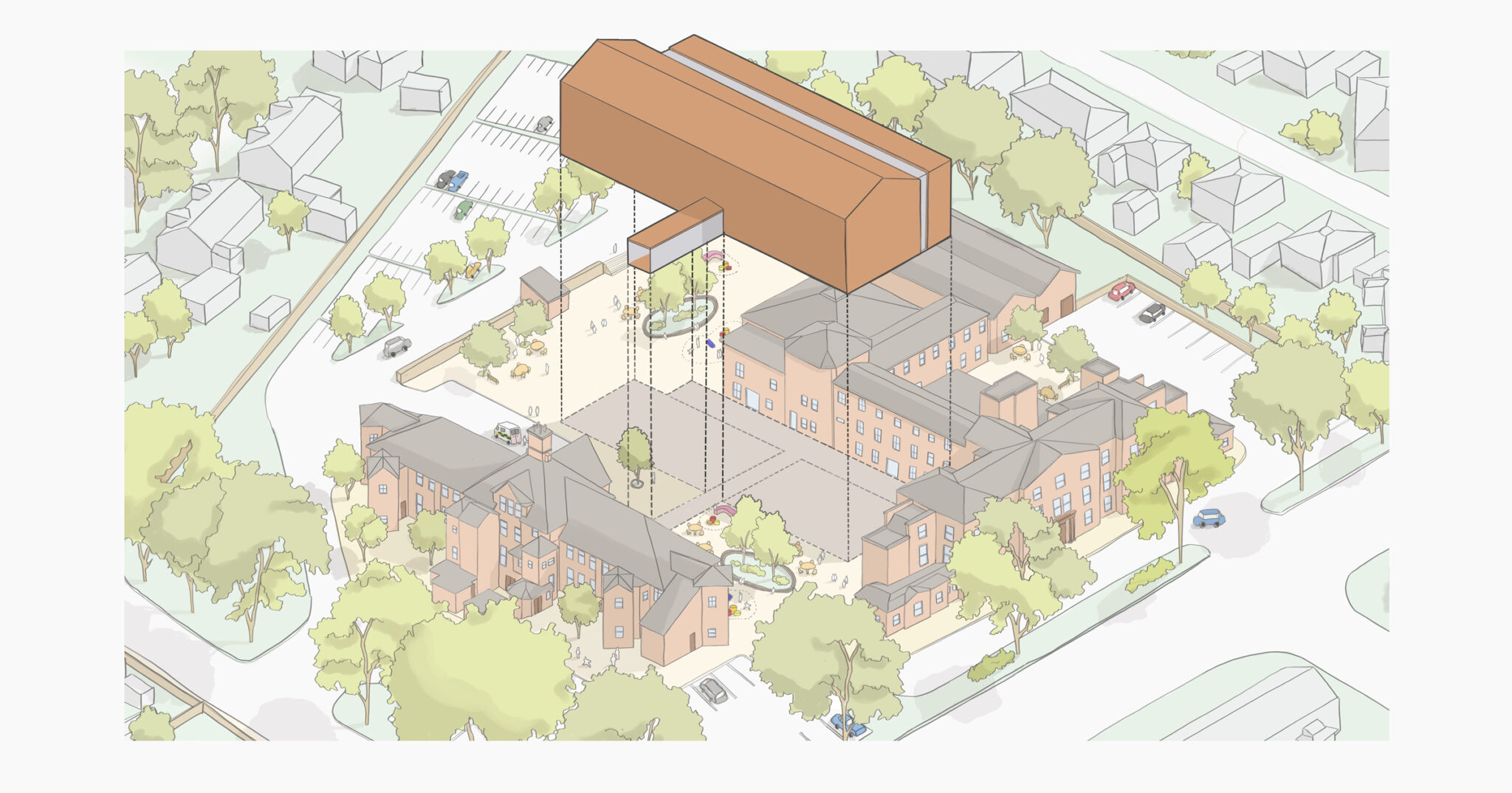
In 2017, the then Secretary of State for Health, Sir Robert Naylor’s independent report highlighted the plight of our ageing health building stock, stating that 18% of the NHS Provider Estate predated the formation of the NHS in 1948, and 43% was more than 30 years old. He concluded that while this is not always a problem, as some older buildings have been upgraded to meet modern standards of care, it is still too often the case that the NHS is operating in inadequate facilities.
Fast forward to the present day, and despite the promises of various hospital building programmes, the situation continues to decline. Levels of backlog maintenance in the NHS continue to rise annually, with an 13.6% increase in 2022/23 to £11.6 billion. In the same period, high-risk backlog maintenance increased by 31% to £2.4 billion. This reflects a proportion of the estate reaching concerning levels of safety.
So, what action should be taken to tackle the inadequacies of the ageing estate? Should we build new and replace, or can we reuse and update?

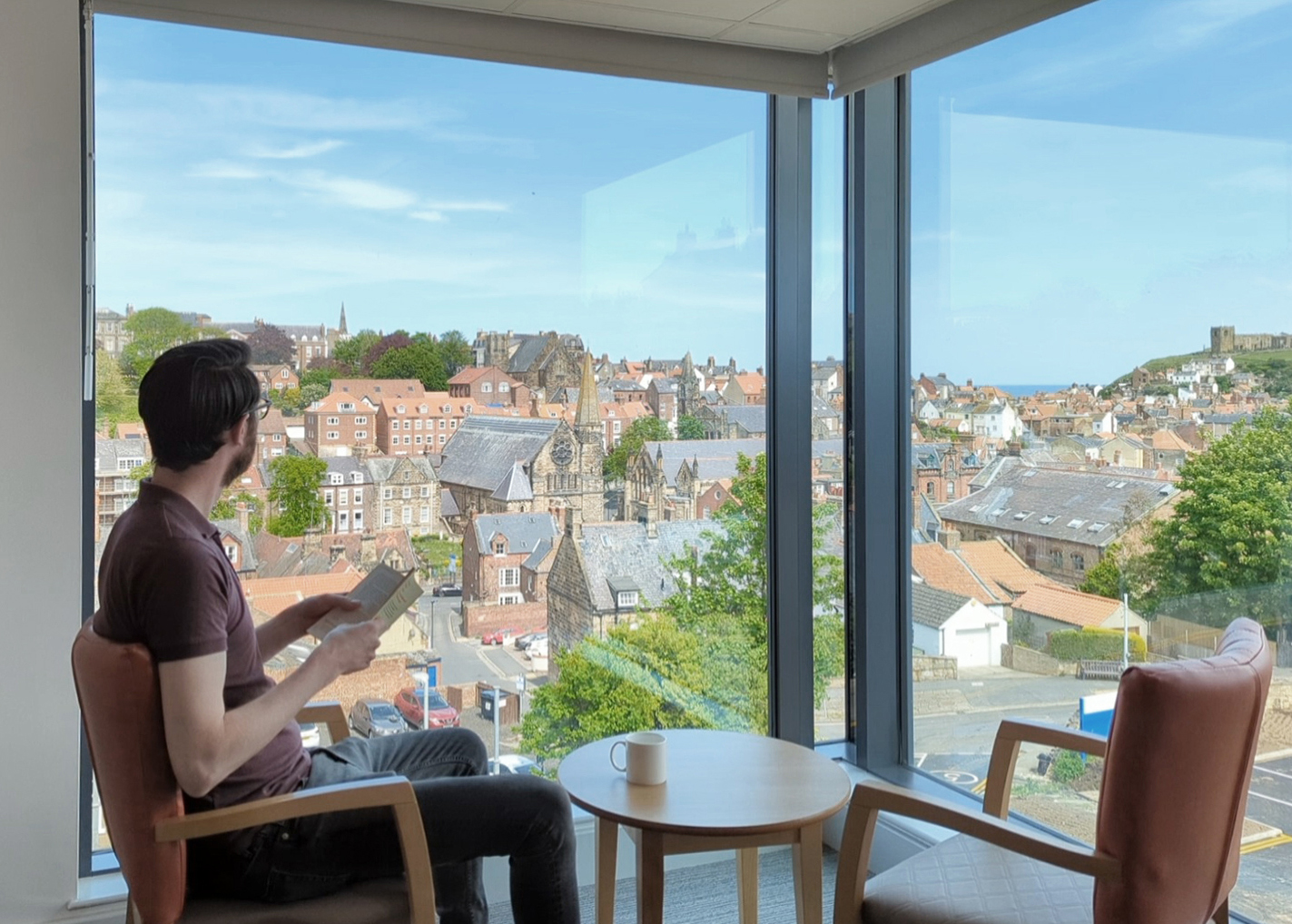
Images of a new hospital building creating flexible facilities for specialist services, and the reuse of an existing community hospital to create an improved environment for patients and staff.
To answer this, we believe it is vitally important to undertake a process of strategic estate planning to set a clear vision for the future of the estate, with a focus on delivering tangible improvements for people and the planet. This provides a structured framework for informed decision making, based on analysis of the existing estate and an understanding of the various — often competing — drivers for change.
The first stage of our process is Estate Analysis, which considers, ‘where we are now’. Healthcare estates are complex and there are many sources of data to analyse and draw conclusions from. We utilise Building Information Modelling and our own innovative digital tools to turn complex data sets into simple and legible visual guides that enable informed decision making. This includes our Estates Register Tool, which collates all available datasets and converts them into a colour-coded dashboard for each property in the estate, enabling Trusts to gain a more informed view of their portfolio. Factors we explore at this stage include capacity and occupancy, physical condition, functional suitability, and sustainability.
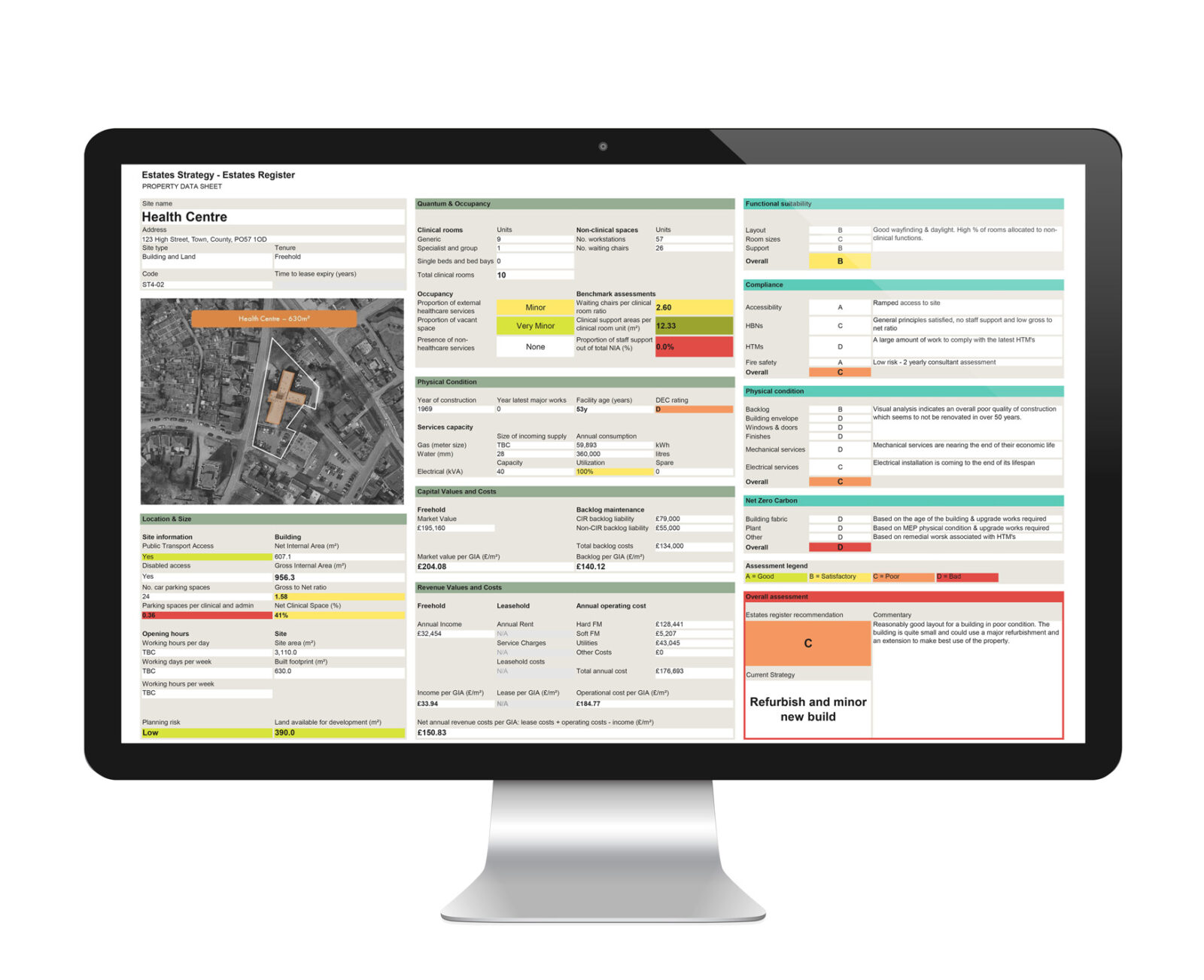
Our custom-designed Estates Register Tool with single-page property dashboard.
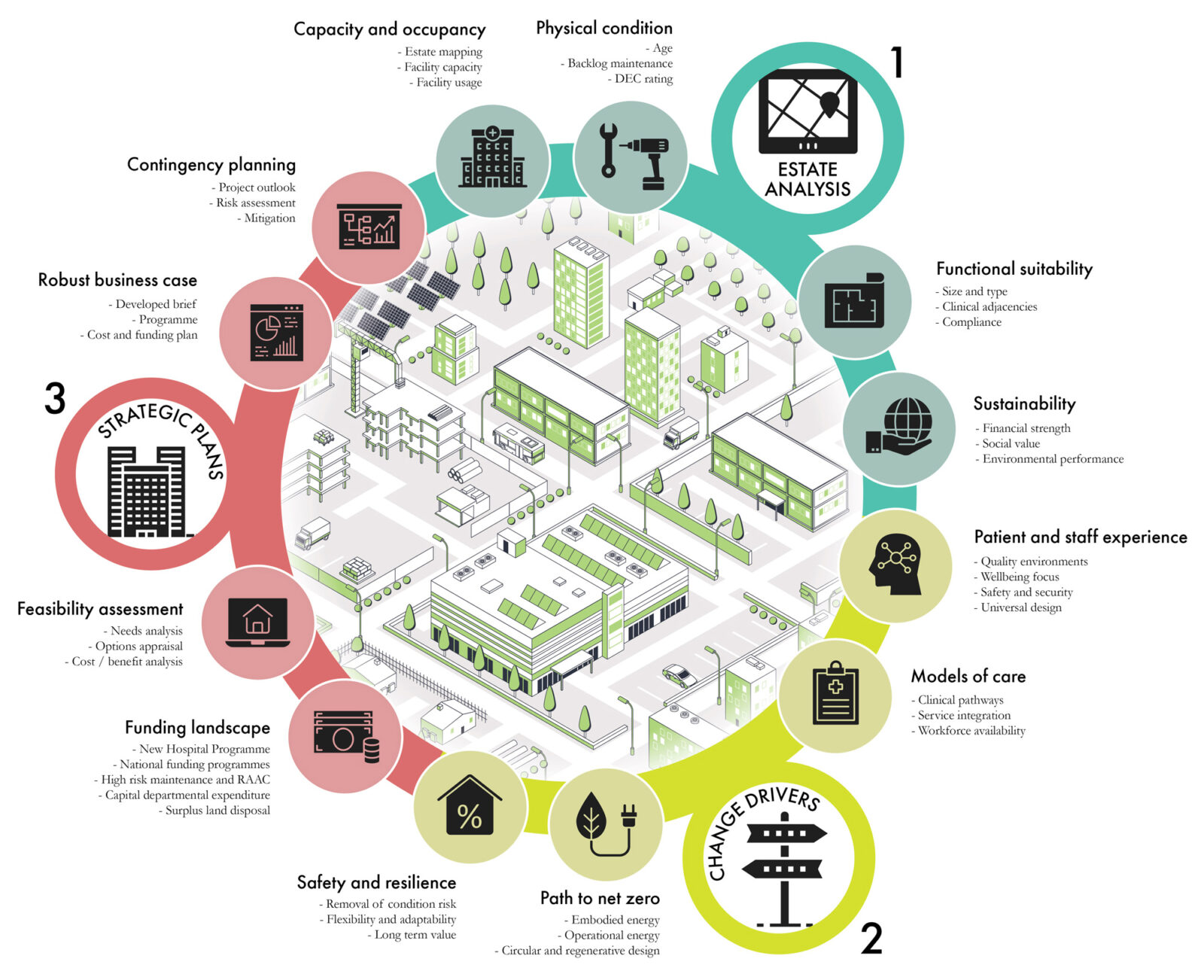
A simplified overview of our strategic estate planning process.
Now we have a good understanding of the existing estate, we look at ‘where we want the estate to be’ in terms of key drivers for change. This is often focused around four main areas:
With an understanding of where we want to be, we can then look at how we can get there, with specific and deliverable strategic plans.
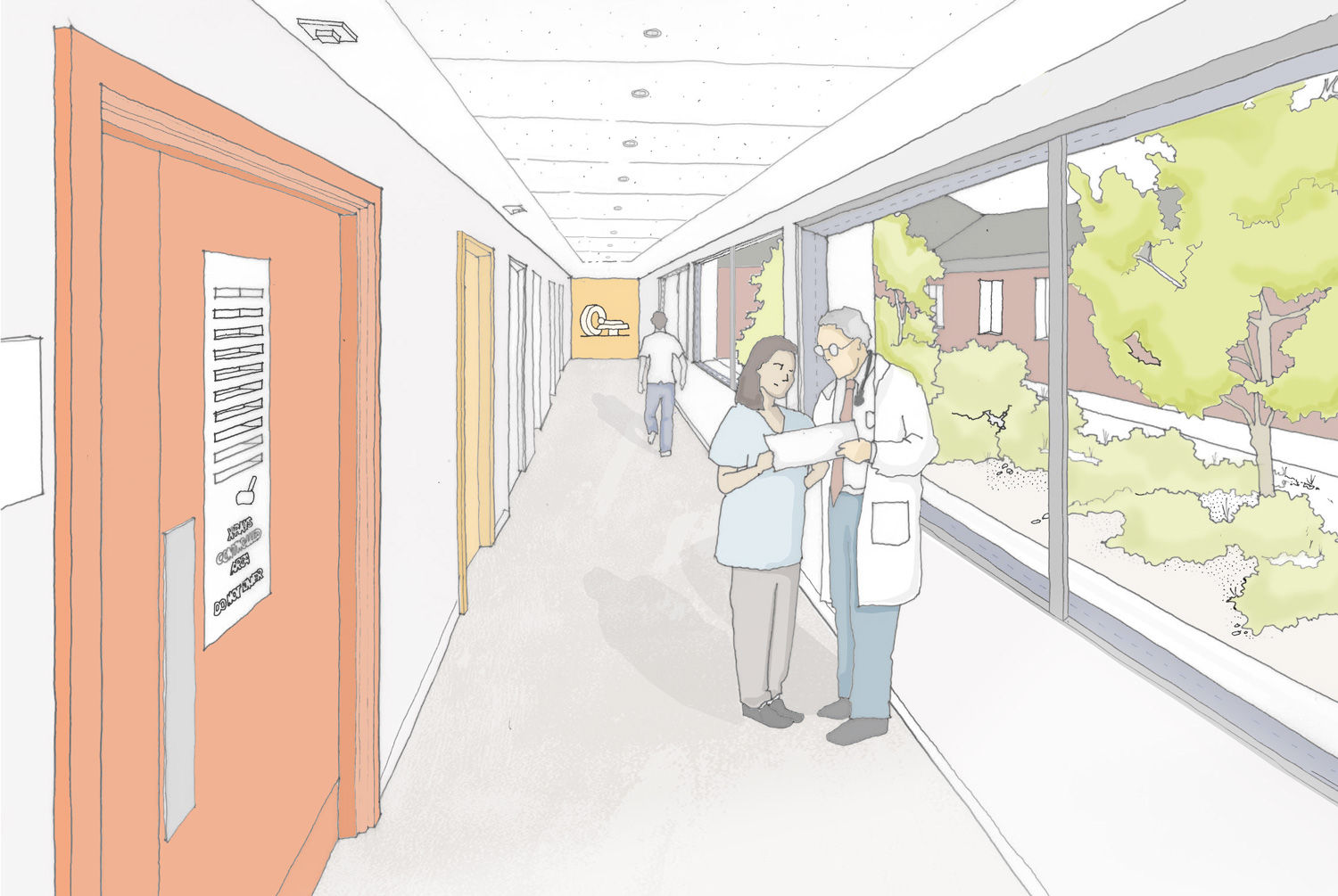
Setting a clear vision for the future of the estate is important to set the standard for development.
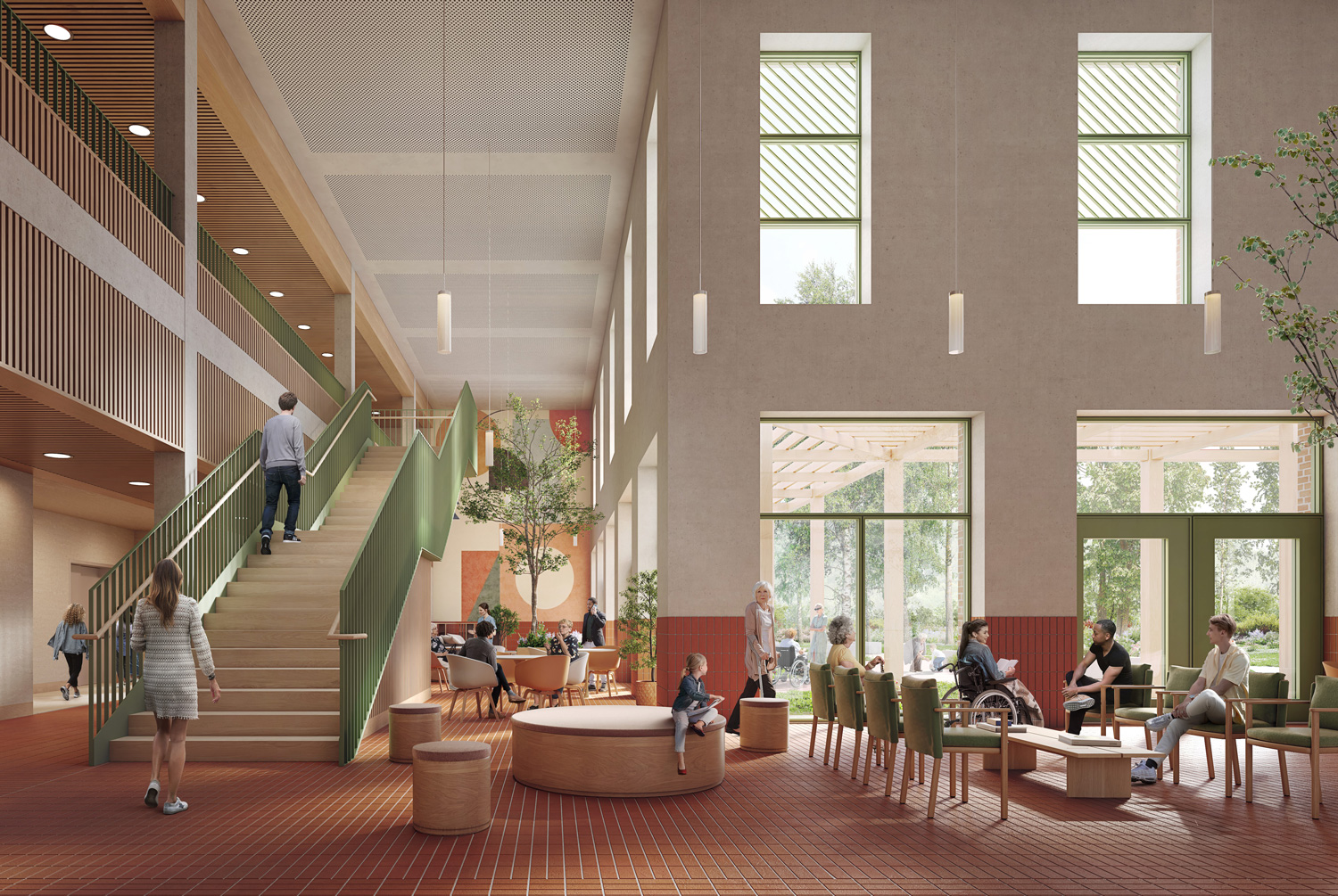
Creating an environment that supports patient wellbeing and recovery is an important driver for change.
Healthcare funding, particularly in the UK, is currently under strain with a level of uncertainty that can make long-term planning difficult. A full review of the funding landscape is essential to understand what is realistic and achievable, whilst delivering long term value.
This will help to define a prioritised programme of investment with detailed option appraisals for refurbishment, new build, and most likely, a combination of the two working together efficiently. This will form the basis for the development of sound and reasoned business cases with which to seek funding. In these uncertain times, it is important to consider contingency planning to assess the potential risks to the proposed plans, building in enough flexibility and adaptability to mitigate for changes, internally and externally.
In our experience this process will lead to a structured programme of interventions ranging from building refurbishments through to new build schemes. Here we look at two recent case studies which demonstrate the value of an informed approach to estate planning.
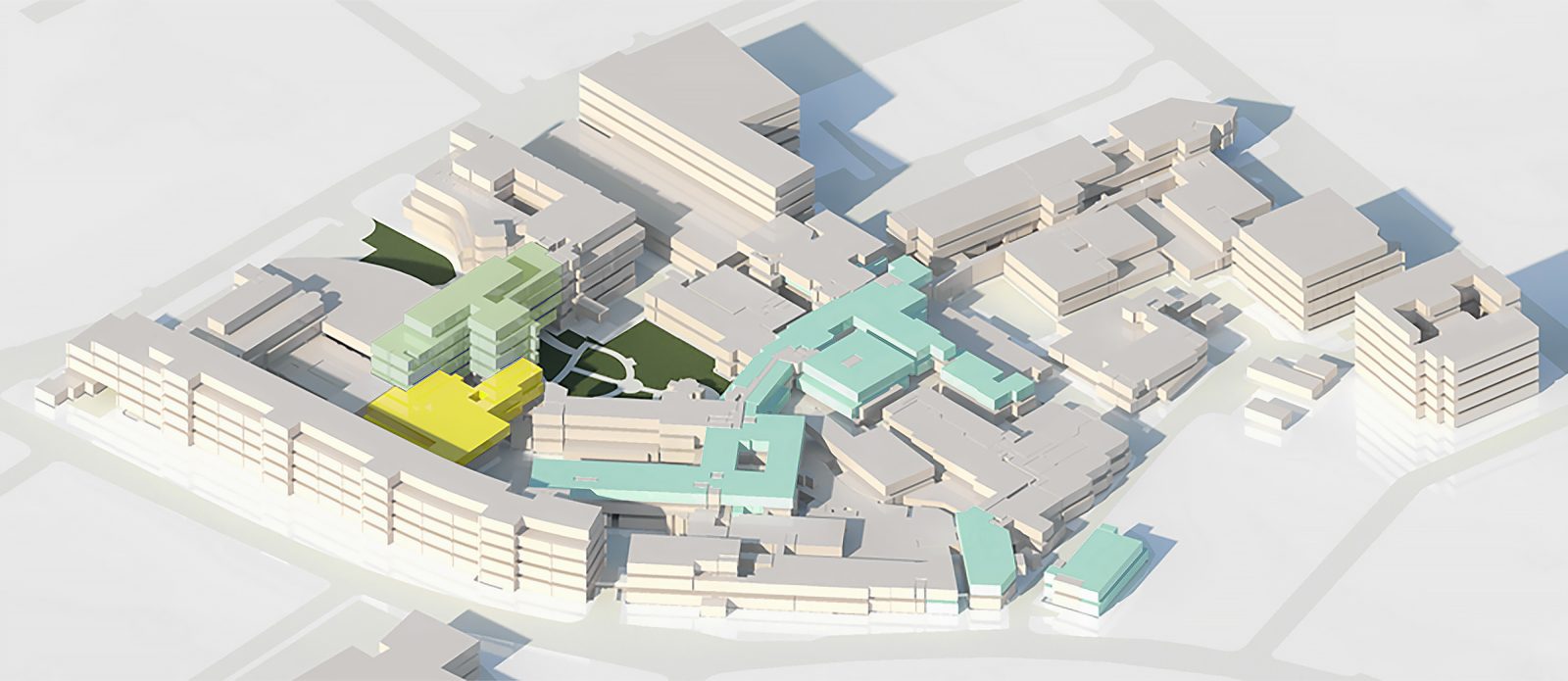
An illustration from an estate strategy and masterplanning exercise which provided a guided framework for investment, through new build and building reuse.
In 2019, we partnered with The Newcastle upon Tyne Hospitals NHS Foundation Trust to assist in the development of their five year estate strategy.
Much of the Trust’s existing building stock—built in the 1970s, 80s and early 90s—had been operating with inefficiencies and configuration issues. We worked closely with the Trust to form a vision for the estate that moved away from ad hoc and opportunistic development and created a guided framework for investment which supports their leadership in sustainable development. The strategy assisted in delivering the Trust’s clinical objectives, by focusing on investment to improve the patient experience and service delivery, as well as fostering enhanced teaching and research. Planned for phased deliverability, it was consistent with the long-term financial model of the Trust and supported cost savings and efficiencies.
The works illustrated in the strategy ranged from strategic refurbishments to significant new build capital investments and were costed and plotted into a 5-year programme, with the flexibility to adapt it to meet changing demands and funding supply. In 2023, the next iteration of the strategy was developed to provide a structured plan for the next 5 years.
Working with Medical Architecture has been a very positive experience and a great collaboration. They provided a facility for us to test our ideas and create a vision for the Trust’s Executives to buy into.
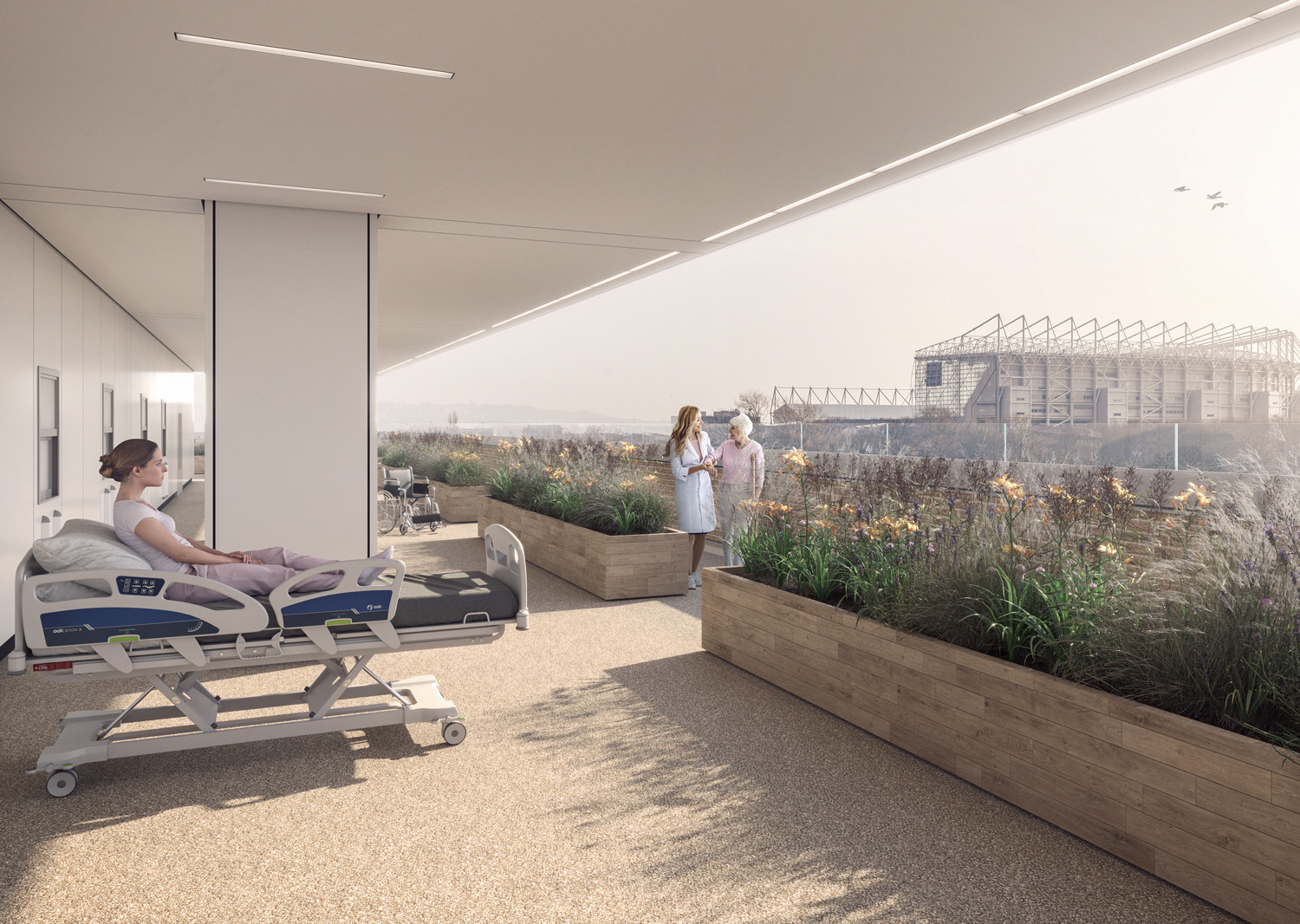
The New Specialist Hospital Building's rooftop outdoor treatment space.
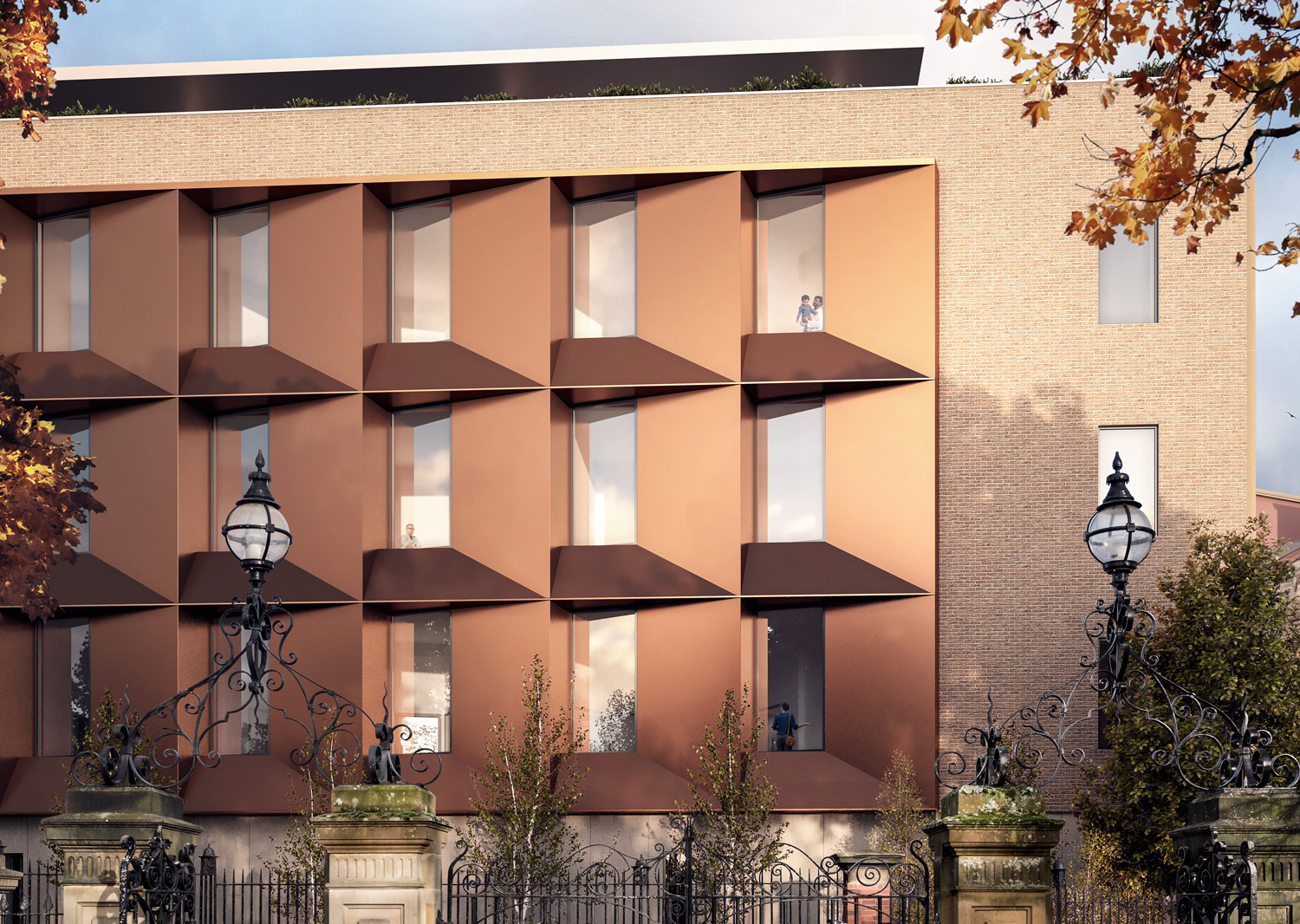
The building has been arranged to exploit views across to the neighbouring park, especially in rooms where long, solitary stays would be expected.
In implementing the estate plan, we were commissioned by the Trust to design a pivotal project, the £225m New Specialist Hospital Building. This carefully planned clinical building provides a sustainable new home for specialist services at the Royal Victoria Infirmary. The building has been designed to be net zero carbon ‘in use’ and to achieve an ‘Outstanding’ BREEAM rating to minimise its environmental impact. It does this while supporting patient wellbeing by prioritising light, space, and therapeutic views to nature. Rooms have been arranged to exploit views to inner courtyards and green spaces which neighbour the site, and a rooftop outdoor treatment space provides bed-bound patients with the benefits of fresh air, views and landscaping, aiding recovery. With the flexibility to adapt to future changes in service delivery, the building will provide long term value for the investment.
Representing a more modest commitment of capital investment, alongside this work, we were commissioned to undertake an Internal Improvement Programme to bring a structured and consistent approach to strategically important refurbishment projects across the Trust’s sites. Here, the considered reuse of existing spaces has significantly reduced the embodied carbon impact, as well as delivering high-quality spaces for excellent value. Designed to a common standard, the internal spaces provide an environment for care that is calming and reduces anxiety, whilst conveying a sense of professional efficiency. Particular attention has been given to design for patients with dementia and frailty, as well as technical standards and guidance compliance, working within the constraints of the existing structures.
Great job by Medical Architecture, what a transformation. Super environment and fantastic for the staff and patients.
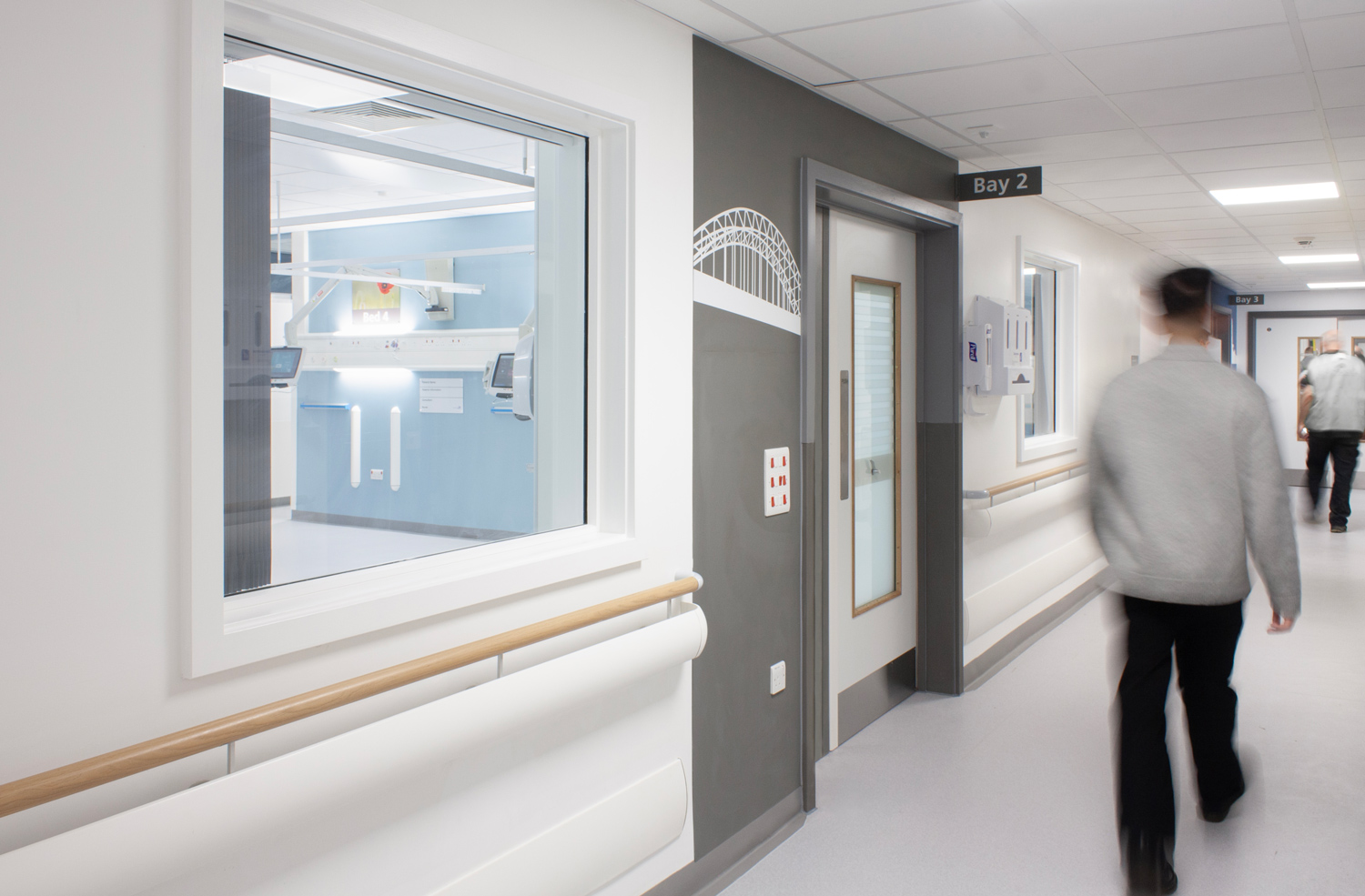
Working with the Trust’s dementia team, an artistic approach to wayfinding was developed for the internal improvement programme, to aid those with cognitive impairment.
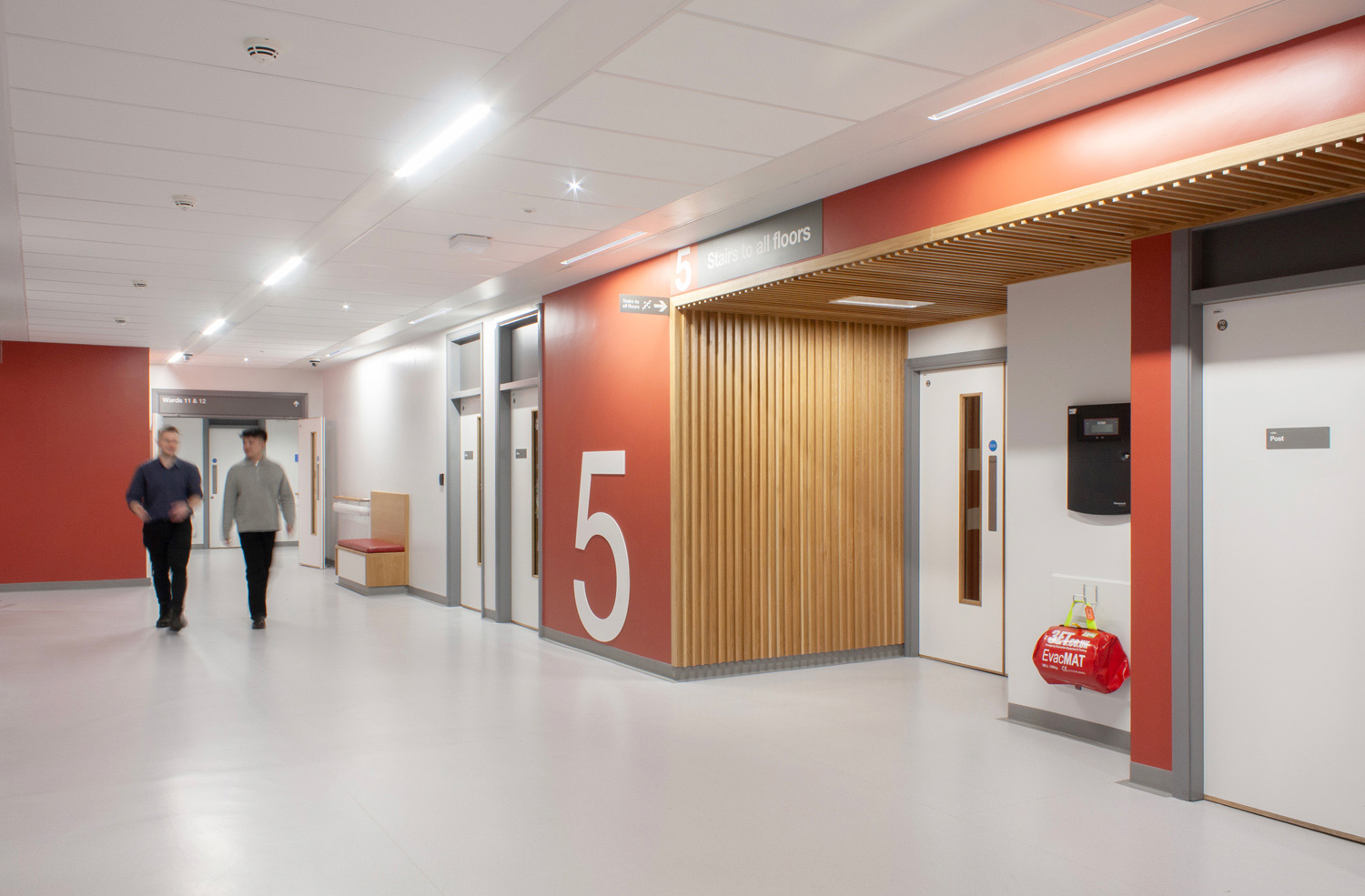
Warm colours and timber finishes were incorporated in the upgraded circulation spaces to improve the environmental qualities of these high-traffic areas.
Midlands Partnership NHS Foundation Trust (MPFT) formed following the merger of two Trusts in 2018 which bought together numerous different estate data sets. We recently worked alongside the new organisation in the development of an Estates Strategy to inform development of 40 properties within their estate.
Early investigations revealed that the existing estate was typical; with as many construction types, building sizes and levels of suitability and condition as there were buildings. The Trust’s database of estates information was very detailed and included six facet surveys for each property. What was missing was any useful context to consider how these properties related to one another within the context of the wider estate, clinical strategy, and future models of care. We used our Estates Register Tool to consolidate all the Trust’s available data sets and recast the data, assessing each site against a defined list of criteria. Scores were assigned and presented in a legible single-page dashboard for each property, allowing a high-level strategic overview of its comparative value.
Adopting a systematic approach and considering each building as part of the wider estate enabled us to support the Trust in developing a comprehensive regional estate strategy. Recommendations within the strategy included retention, retention with investment, and asset disposal to fund improvements elsewhere. Proposed investments range from interior refurbishment to extension and new build, depending on the local requirements and the suitability of the existing asset.
Our estates team’s collaboration with Medical Architecture has produced a bespoke register which identifies investment priorities and helps us to ensure that our estate aligns with long-term strategic and clinical objectives.
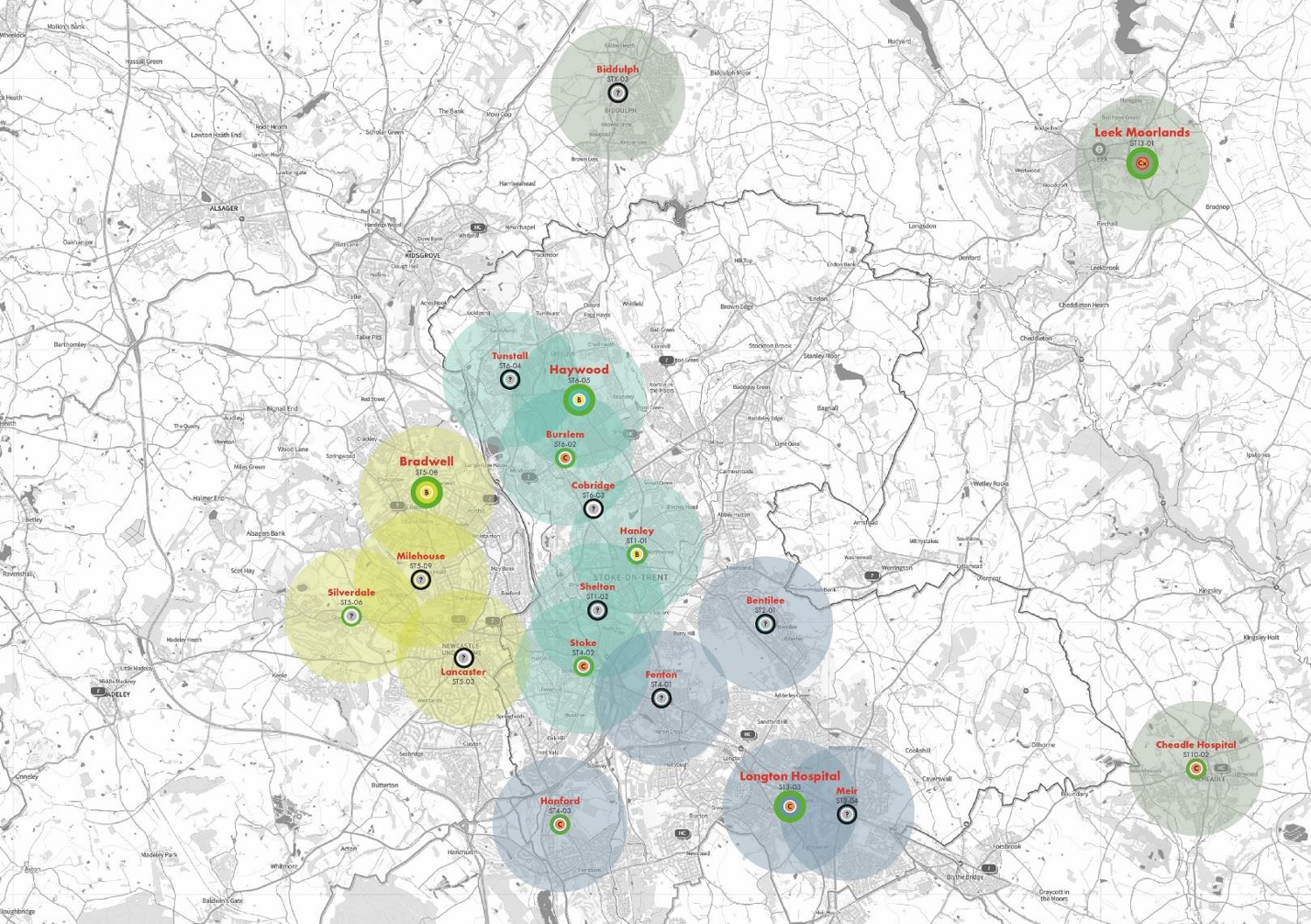
Digital tools were used to turn complex data sets into simple and legible visual guides, enabling informed decision making.
We started this piece by asking, should we build new and replace, or can we reuse and update? Ultimately our experience tells us that there is no simple answer to this question. Of course, to tackle the impacts of climate change, we must be efficient with our use of resources, and this includes existing buildings. Where adaptation and reuse of existing buildings can provide appropriate facilities, which offer value for the NHS and a positive care environment for patients and staff, then these opportunities should be taken. Unfortunately, not all buildings were built with the longevity, flexibility or adaptability to be of value in the long term. Changing needs, technologies, and models of care also mean that existing buildings don’t always provide suitable environments to support wellbeing and recovery. In these circumstances, there will be a legitimate business case for investment in new facilities. Making sure that these decisions are taken within the context of an informed strategic plan, ensures that priorities are aligned and deliverable, ensuring value for investment over the long term.
Before we got involved with Medical Architecture we had one of the worst performing estates, now we have one of the best, with award winning developments attracting international interest.
We recently assisted the client of a pioneering proton beam therapy centre, acting in an advisory role to ensure compliance. Here we share some of our learnings from the process.